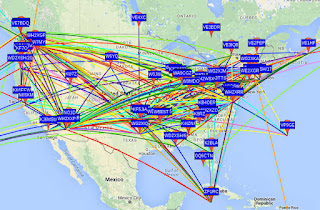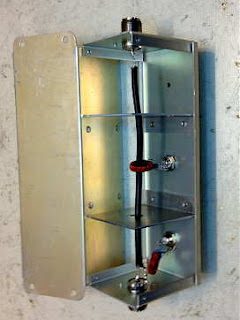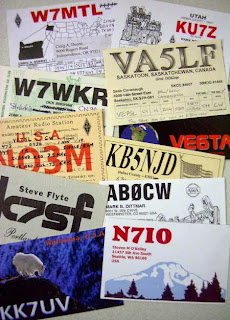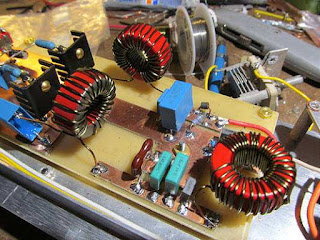Posts Tagged ‘630m’
 New VE7 On 630m
New VE7 On 630m
Another VE7 is almost ready to deploy on 630m.
There must be something special in the water in B.C. as it is certainly the present hotbed of 630m activity in Canada!
Markus, VE7CA, in North Vancouver, has been busy building a transmitter and a matching VFO, following the plans of GW3UEP. There must now be dozens and dozens of these robust little transmitters in operation around the world as it is easily reproducible (in various forms) and performs well. See the sidebar links for more details.
As well, Markus has been building the necessary auxiliary gear needed to tune up and resonate his antenna system. His recently constructed variometer and scopematch are shown below.
Some might argue of the necessity for a scopematch, but once you've tried it, you wonder how you could ever live without it ... the scopematch makes tuning the antenna system a very simple step and is an extremely valuable addition to the LF/MF shack.
Markus plans on using his main low band antenna, a large ladder-line fed horizontal loop, as a top-loaded vertical, while resonating the system with base-loading. A homebrew relay-control box at the antenna, takes care of switching between MF and HF.
I had a nice CW QSO today on 476.0 kHz with Toby, VE7CNF. He has made some significant changes at his station and his 20dB over S9 signal reflects his hard work. As well as rebuilding his top-loaded vertical, he has made modifications to his PA. Using a pair of IRFP4227 switching FETs in push-pull, his amplifier now brings him to the maximum EIRP limit of 5W. See a description of Toby's interesting station on his website here. When not on CW, Toby can be heard WSPR'ing, most evenings on 630m.
With the soon-to-arrive VE7CA, we almost have enough activity here in the Vancouver region, for a weekly 630m net or at least a good chance of a random 'CQ' garnering a response. How great it would be to have a VE6 or VE5 to join-in ... what say fellas!
 472kHz preamp – a good idea?
472kHz preamp – a good idea?
The FT817 is a bit low in sensitivity on 472kHz so I was expecting a decent improvement with a preamp. To my surprise I am copying no more stations. In fact I am hearing just as many without as with! The result has surprised me. The rig sensitivity is definitely better with the preamp and stations are stronger but it is far from clear cut whether it is worth using it in reality. At the moment my 472kHz transverter does not have the preamp.
Maybe the FT817 sensitivity is good enough. In marginal cases (and these seem few) it probably helps, but most of the time it seems fine without.
 Upcoming 630m Crossband Weekend
Upcoming 630m Crossband Weekend
 This coming weekend will see the annual '630m activity event' on Friday and Saturday night.
This coming weekend will see the annual '630m activity event' on Friday and Saturday night.There will be a lot of activity from both the U.S. experimental stations and from a group of five Canadian amateurs who will be seeking two-way CW 'crossband' contacts.
The five Canadians will be transmitting on 630m CW but listening for answering stations on various HF (QSX) frequencies. Last year's one-night event was a great success ... hopefuly the two-night event this year will lead to even more participation by interested amateurs in both Canada and the U.S.
Unlike Canadian hams, American amateurs does not yet have access to 630m as a ham band but ... there will be a large number of U.S. 'experimental' stations (most of them operated by hams with an experimental licence) beaconing and working each other and seeking your 'heard' reports. The Canadian operation will give interested hams the actual opportunity to make a two-way MF to HF CW contact, via the crossband mode as well as provide the Canadians an opportunity to test their 630m systems.
Here are the details of the five Canadian crossbanders:
Station: VO1NA (Joe) GN37 Torbay, Newfoundland
Time: 2130Z - 0130Z both Friday night (Nov 13-14Z) / Saturday night (Nov
14-15Z)
TX Frequency: 477.7 kHz
RX (QSX) Frequency: 3562 kHz
Station: VE7SL (Steve) CN88 Mayne Island, B.C.
Time: 0200Z - 0700Z both Friday night (Nov 14Z) / Saturday night (Nov 15Z)
TX Frequency: 473.0 kHz
RX (QSX) Frequency: 3566 / 7066 kHz
Station: VE7BDQ (John) CN89 Delta, B.C.
Time: 0430Z - 0700Z both Friday night (Nov 14Z) / Saturday night (Nov 15Z)
TX Frequency: 474.0 kHz
RX (QSX) Frequency: 3536 kHz
Station: VA7MM (Mark) CN89 Coquitlam, B.C.
Time: 0500Z - 0700Z Friday (Nov 14Z)
0400Z - 0800Z Saturday (Nov 15Z)
TX Frequency: 475.0 kHz
RX (QSX) Frequency: 3570 kHz
Station: VE7CNF (Toby) CN89 Burnaby, B.C.
Time: 0300Z - 0700Z both Friday night (Nov 14Z) / Saturday night (Nov 15Z)
TX Frequency: 476.0 kHz
RX (QSX) Frequency: 3558 kHz / 7062 kHz
All stations will either call CQ or run "VVV" marker beacons while listening on their respective QSX frequencies. QSX frequencies will be included
in the CQ or marker beacons.
Last year's event saw many nice contacts, some of them from coast-to-coast! I really hope that as many amateurs as possible will have a listen and be able to answer our 'CQ's on the various QSX frequencies. Your participation on one (or both) of the two night's activity would be just great.
I will post a reminder of the event again at the end of the week ... in the meantime, try to see what you can hear on 630m (472-479kHz) and arrange your setup so that you can call us on HF as well.
For a more detailed description of the upcoming event, see the ARRL's announcement here.
 630m Heating Up
630m Heating Up

In spite of the sun's nasty and continual huffing and puffing, conditions on 630m continue to surprise many of the nightly diehards. It seems clear, that for the time being, the digital WSPR mode is the one chosen by the majority of operators. I suspect that this will change to a more proportionate mix of both CW and digital, as more Canadians get on the band but more particularly, when U.S. amateurs get permanent access to 630m as a ham band. At present, it's mostly listeners reporting beacons, demonstrating the propagational capabilities to be found at the bottom of the broadcast band.
Last night saw over 80 stations worldwide, either listening or transmitting on 630m, with the majority of them in the 'listening mode' only.
 |
| courtesy: http://njdtechnologies.net/ |
It was particularly nice to see locals, VE7BDQ and VE7CNF being heard in the Cayman Islands and Hawaii, respectively ... both suburban backyard operations. The previous morning saw the experimental station run by Larry, W7IUV in Washington state, being heard in Japan by JA1NQI ... a first from the lower 48 into Japan.
Things over in Europe have also been heating-up and the nightly reports read more like a roster of 20m action. FR5ZX on Reunion Island in the Indian Ocean has been reporting many of the Europeans, making things more interesting for the dedicated in that part of the world. All of the reports were on the WSPR mode.
John (KB5NJD / WG2XIQ) in Texas, continues to post his amazingly-detailed nightly updates of 630m action. If you want to know what's been happening both here and in the rest of the world, his daily updates will keep you in the loop ... but be warned, as you will likely find yourself heading for 630m yourself to get in on the nightly activity. In addition, his blog contains a goldmine of information for those wanting to get started with building a 630m MF station. To really keep tabs of real-time happenings, the ON4KST MF chat page is the place to be.
Next weekend, the 630m CW crossband activity will take place, with 5 different Canadian CW stations CQing on 630m CW and listening for callers on various HF frequencies on 80 and 40m. I will have the details up here again shortly, but please give a listen for us on 630m as well as a call on HF, next Friday or Saturday (or both!) nights ... the more the merrier, and tell your friends too!
 West Coast 630m Growth
West Coast 630m Growth

The Canadian west coast contingent of stations on 630m continues to slowly expand, with Mark, VA7MM and Toby, VE7CNF now operational at 'DX capable' power levels.
Both Mark and Toby have been refining their antenna systems with an eye towards the upcoming winter season as well as the November 'crossband' activity weekend ... both stations were heard testing this week and are sounding very strong at my Mayne Island location.
Toby has sent a picture of his antenna loading coil and variometer scheme, shown below.
"You can see the white slider knob at the lower left, which goes through a slot in the outer pipe and screws into the end of the inner pipe. The white wire at the right goes to the matching transformer, and the black high-voltage wire at the left goes to the antenna. The coil is wound with #14 so it can handle some power. There are ventilation holes around the pipe and at the ends, but at 200W I did not notice any warming. A regular rotating variometer may have slightly lower losses, but it would be larger and I wanted to make my tuner box small so I can hide it near the trees."
 Mark also sent some pictures of his recent handiwork, showing the simple loading coil and tuning system presently in use at his station. His present plans call for something capable of handling power in the 100 watt range and, although using smaller gauge wire, the loading coil seems to handle it just fine. Like Toby, he is using a 'sliding variometer' and a toroidal autotransformer for impedance matching to 50 ohms. Mark will be running ~ 100 watts into a 100' vertical wire with top-loading.
Mark also sent some pictures of his recent handiwork, showing the simple loading coil and tuning system presently in use at his station. His present plans call for something capable of handling power in the 100 watt range and, although using smaller gauge wire, the loading coil seems to handle it just fine. Like Toby, he is using a 'sliding variometer' and a toroidal autotransformer for impedance matching to 50 ohms. Mark will be running ~ 100 watts into a 100' vertical wire with top-loading.It is wonderful to see more new stations arriving on the band but the new activity seems to be coming from VE7 only ... how interesting it would be to have stations in VE6, the prairies and especially from Ontario, which has many more hams than any of the other provinces. The opportunities presented to Canadian amateurs by the new band are both boundless and challenging and there is so much that can be learned by 'jumping in'!
Another western amateur has caught the 630m bug, this one from the U.S.A. Steve, KK7UV, in Montana, has been busy building new antennas as well as a new GW3UEP transmitter. Operating with an experimental licence, WH2XNV, Steve has been putting a nice CW signal up this way during the evenings and is all set for the winter and, hopefully, for the fast-approaching day when the boys on the other side of the border get full access to 630m as a ham band. All of us up here very much look forward to working our U.S. counterparts very soon.
Steve's new antenna consists of an 81' vertical wire, top-loaded with a 3-wire 68' x 8' tophat. His ground system now has over 4,000' of radials, ranging in size from 40'-130'.
Steve also reports modifying his dual-FET (parallelled) GW3UEP transmitter from the original solenoid-wound coils to toroidal cores, increasing efficiency from 74% to 77%.
As well, he also went to a single-FET (per the original design) and garnered a further increase in efficiency, now at 86% and 82 watts out ... plenty of power to do some useful work on the band. It's wonderful to see how 630 meters brings out the 'experimenter' in all of us. He also reports that he's "having a bunch of fun at this ... "!
If homebrewing is your main interest, all of the 630m stations that I'm familiar with are using home-built transmitters. Maybe you like tinkering with antennas? This band is perfect for the design and development of small, yet effective, backyard antennas ... most will be surprised at how little is needed to radiate a usable signal on 630m. Perhaps propagation is your main interest? There is still much to be learned about the capabilities of our stations, operating at amateur radio power levels, in the MF band.
As mentioned before, we are really very fortunate here in Canada, to have this amazingly interesting part of the radio spectrum made available to us ... let's try and use it, from coast to coast and everywhere in between.
VE6, VE5, VE4, VE3, VE2 and VE1 ... the band needs you!
 Hunting For NDBs In CLE 199
Hunting For NDBs In CLE 199
 |
| 'ZVR-368kHz' at Vancouver International |
It's time for another CLE (Co-ordinated Listening Event) once again! For you low-frequency buffs, another challenge awaits. This month's activity covers the range of 190 - 1740 kHz.
CLE 199 is an 'A-B-C' activity ... a little different from the norm, and listeners are requested to report NDB's from countries, states or provinces, beginning with the letter A, B & C only. Listeners in western NA will find plenty of targets but it might be a challenge for those on the eastern side.
A list of eligible 'A-B-C' entities can be found at the bottom. Additionally, a list of all of the North American targets in this frequency range can be found in the RNA database, while targets for European DXers will be found here ... either chose the 'Seeklist' button or search for the desired state, province or country for detailed frequency information.
A nice target for this CLE is 'ZVR' (368kHz) shown above. The 20W locator from Vancouver International, has been heard from Hawaii to North Carolina. It is located a little east of YVR, in a boggy farmland region.
From CLE coordinator Brian Keyte (G3SIA) comes the following reminder:
Hello all
Almost time for our 11th 'Countries' Listening Event. Whether you are a
regular, or have never sent a CLE log before, your log will be very welcome.
Days: Friday 23 October - Monday 26 October
Times: Start and end at midday, your local time.
Targets: 'Normal' NDBs (190 - 1740 kHz) - not DGPS, Navtex
or Amateur - located in the Radio Countries whose
codes start with A, B or C.
These are our 2-letter codes for the Provinces/States of Canada and USA
and our 3-letter codes elsewhere, including AUS (Australia) -all its States.
The full list of all qualifying countries is given at the end of this email.
Detailed seeklists are available from the Rxx database - just select
SEEKLIST on the CLE page, http://www.ndblist.info/cle.htm
Martin has also added a 'Seeklist Map' facility there too.
If you are in the east of N. America it may be quite a tough challenge.
Most other listeners should be in luck this time, including several who
usually have a hard time.
Please send your CLE log to the List (no attachments and a plain text email
if possible) with CLE199 at the start of its title. Show on each log line:
# The Date (or Day No. 23 to 26)
# The Time in UTC** (the day changes at 00:00 UTC).
# kHz - the nominal published frequency, if known.
# The Call Ident.
**Many of us will be changing our clocks by one hour this weekend
but UTC time continues without any change.
Please show the above main items FIRST on each line of your log.
Any other optional details such as Country, Location, Distance, etc.
go LATER in the same line.
If you send any interim logs, please also send a 'Final' (complete) log.
Always tell us your own location and brief details of the equipment
that you were using.
Do make sure that your log has arrived by 09:00 UTC on
Wednesday 28 October at the very latest.
I hope to complete making the combined results on that day.
Good listening.
Enjoy the hunt!
Brian
----------------------------------------------------------
From: Brian Keyte G3SIA ndbcle'at'gmail.com
Location: Surrey, SE England (CLE co-ordinator)
----------------------------------------------------------
(Reminder: You could use any one remote receiver for your loggings,
stating its location and owner - with their permission if required.
A remote listener may NOT also use another receiver, whether local
or remote, to obtain further loggings for the same CLE)
These listening events serve several purposes. They:
- determine, worldwide, which beacons are actually in service and on-the-air so the online database can be kept up-to-date
- determine, worldwide, which beacons are out-of-service or have gone silent since the last CLE covering this range
- will indicate the state of propagation conditions at the various participant locations
- will give you an indication of how well your LF/MF receiving system is working
- give participants a fun yet challenging activity to keep their listening skills honed
Final details can be found at the NDB List website, and worldwide results, for every participant, will be posted there a few days after the event. If you are a member of the ndblist Group, results will also be e-mailed and posted there.
The very active Yahoo ndblist Group is a great place to learn more about the 'Art of NDB DXing' or to meet other listeners in your region. There is a lot of good information available there and new members are always very welcome.
If you are contemplating getting started on 630m, listening for NDBs is an excellent way to test out your receive capabilities as there are several NDBs located near this part of the spectrum.
You need not be an ndblist member to participate in the CLEs and all reports, no matter how small, are of much value to the organizers. 'First-time' logs are always VERY welcome!
Reports may be sent to the ndblist or e-mailed to either myself or CLE co-ordinator, Brian Keyte (G3SIA), whose address appears above.
Please ... give the CLE a try ... then let us know what NDB's can be heard from your location! Your report can then be added to the worldwide database to help keep it up-to-date.
EXTRACTS FROM OUR COUNTRY LIST Last revised: 23 Oct 2006
( http://www.ndblist.info/ndbinfo/countrylist.pdf )
SHOWING ALL THE QUALIFYING COUNTRIES FOR THE CLE
NORTH AMERICA:
ALS ALASKA (US state)
BER BERMUDA (UK)
AB Alberta, Canada
BC British Columbia, Canada
AL Alabama, USA
AZ Arizona, USA
AR Arkansas, USA
CA California, USA
CO Colorado, USA
CT Connecticut, USA
CENTRAL AMERICA/CARIBBEAN:
AIA ANGUILLA
ATG ANTIGUA & BARBUDA
ABW ARUBA
BAH BAHAMAS
BRB BARBADOS
BLZ BELIZE
CYM CAYMAN ISLANDS
CTR COSTA RICA
CUB CUBA
ATN NETHERLANDS ANTILLES
BAR ST BARTHELEMY
SOUTH AMERICA:
ARG ARGENTINA
BOL BOLIVIA
BRA BRAZIL
CHL CHILE
CLM COLOMBIA
EUROPE:
ALB ALBANIA
AND ANDORRA
AUT AUSTRIA
AZR AZORES (PORTUGAL)
BRI REAR ISLAND / BJORNOYA (NORWAY)
BLR BELARUS
BEL BELGIUM
BAL BALEARIC ISLANDS (SPAIN)
BIH BOSNIA-HERCEGOVINA
BUL BULGARIA
COR CORSICA (FRANCE)
CZE CZECH REPUBLIC
CVA VATICAN STATE
AFRICA:
ALG ALGERIA
AGL ANGOLA
ASC ASCENSION ISLAND (UK)
BEN BENIN
BOT BOTSWANA
BFA BURKINA FASO
BDI BURUNDI
CAB CABINDA (ANGOLA)
CME CAMEROON
CNR CANARY ISLANDS (SPAIN)
CPV CAPE VERDE
CAF CENTRAL AFRICAN REPUBLIC
CEU CEUTA (SPAIN)
COM COMOROS
COG CONGO-BRAZZAVILLE
COD CONGO-KINSHASA
CTI IVORY COAST
AFS SOUTH AFRICA
AOE WESTERN SAHARA
ASIA:
AFG AFGHANISTAN
ANI ANDAMAN & NICOBAR ISLANDS (INDIA)
ARM ARMENIA
AZE AZERBAIJAN
BHR BAHRAIN
BGD BANGLADESH
BTN BHUTAN
BRU BRUNEI
CBG CAMBODIA
CHN CHINA (PRC)
CHR CHRISTMAS ISLAND (AUSTRALIA)
CYP CYPRUS
BRM MYANMAR (BURMA)
ARS SAUDI ARABIA
CLN SRI LANKA
OCEANIA:
AUI AUSTRAL ISLANDS (FRANCE)
AUS AUSTRALIA ( all States: AT, NW, NN, QD, SA, TA, VI, WE )
CLI CLIPPERTON (FRANCE)
CKH COOK ISLANDS (NORTHERN)
CKS COOK ISLANDS (SOUTHERN)
ANTARCTICA:
ATA ANTARCTICA MAINLAND
 630m Crossband Schedule
630m Crossband Schedule
 |
| VO1NA Torbay, Newfoundland |
There are now five Canadian amateurs slated to operate over the course of the two-night event (Friday & Saturday) and they will be looking for two-way crossband contacts with amateurs in the U.S. and Canada. Here is the schedule of frequencies and times:
Station: VO1NA (Joe) GN37 Torbay, Newfoundland
Time: 2130Z - 0130Z both Friday night (Nov 13-14Z) / Saturday night (Nov 14-15Z)
TX Frequency: 477.7 kHz
RX (QSX) Frequency: 3562 kHz
Station: VE7SL (Steve) CN88 Mayne Island, B.C.
Time: 0200Z - 0700Z both Friday night (Nov 14Z) / Saturday night (Nov 15Z)
TX Frequency: 473.0 kHz
RX (QSX) Frequency: 3566 / 7066 kHz
Station: VE7BDQ (John) CN89 Delta, B.C.
Time: 0430Z - 0700Z both Friday night (Nov 14Z) / Saturday night (Nov 15Z)
TX Frequency: 474.0 kHz
RX (QSX) Frequency: 3536 kHz
Station: VA7MM (Mark) CN89 Coquitlam, B.C.
Time: 0500Z - 0700Z Friday (Nov 14Z)
0400Z - 0800Z Saturday (Nov 15Z)
TX Frequency: 475.0 kHz
RX (QSX) Frequency: 3570 kHz
Station: VE7CNF (Toby) CN89 Burnaby, B.C.
Time: 0300Z - 0700Z both Friday night (Nov 14Z) / Saturday night (Nov 15Z)
TX Frequency: 476.0 kHz
RX (QSX) Frequency: 3558 kHz / 7062 kHz
These stations will be calling CQ on CW at regular intervals throughout the evening, and listening for answers on the allocated HF call-back (QSX) frequency. The sequence that I will be using (and others in a similar fashion) is:
"CQ CQ CQ de VE7SL VE7SL VE7SL QSX 3566 and 7066kHz K". After listening for callers on either QSX frequency for approximately 30 seconds, the CQ will be repeated if no callers are heard.
With good conditions, propagation can often span the continent, so please consider taking part in the activity from wherever you might be located in North America. Last year, crossband contacts were made between here and W3 / W5 and many points in between.
For eastern stations, VO1NA, in Newfoundland, should be a tantalizing target with coverage throughout the eastern states while the four VE7 stations should prove workable for central and western North American amateurs.
Those that might wonder about the 'legality' of crossband contacts need not worry. Canadian amateurs have had legal access to 630m for almost two years now and crossband contacts with any stations in the amateur radio service are the same as a two-way QSO on any other band. Unfortunately, amateurs are not allowed to contact any of the experimentally-licenced stations ... they are permitted to work each other only.
Hopefully you will print out the operating schedule and consider participating in the November crossband activity weekend ... the more the merrier! It would be great to see even more contacts than last year, which was a great start, considering the less than optimum conditions. I will post more details as the event weekend draws closer. We hope to see you there!






















